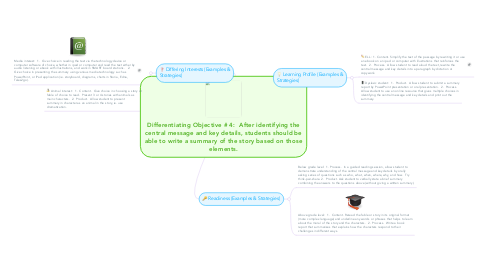Differentiating Objective # 4: After identifying the central message and key details, students should be able to write a summary of the story based on those elements.
by hannah lee

1. Differing Interests (Examples & Strategies)
1.1. Media interest: 1. Give choice in reading the text via the technology device or computer software of choice, whether in ipad or computer and read the text either by audio listening or ebook with illustrations, and work in SMART board stations. 2. Give choice in presenting the summary using various media technology such as PowerPoint, or iPad application (ie. storyboard, diagrams, charts in Storia, Edna, Tales2go).
1.2. Animal interest: 1. Content. Give choice in choosing a story or fable of choice to read. Present 3 or 4 stories with animals as main characters. 2. Product. Allow student to present summary in character as an animal in the story, ie. use dramatization.
2. Learning Profile (Examples & Strategies)
2.1. ELL: 1. Content. Simplify the text of the passage by rewriting it or use an ebook on an ipad or computer with illustrations that reinforces the text. 2. Process. Allow student to read aloud the text, rewrite the central message and key details into a paragraph by dictation or copywork.
2.2. Dyslexic student: 1. Product. Allow student to submit a summary report by PowerPoint presentation or oral presentation. 2. Process. Allow student to use an online resource that gives multiple choices in identifying the central message and key details and print out the summary.
3. Readiness (Examples & Strategies)
3.1. Below grade level: 1. Process. In a guided reading session, allow student to demonstrate understanding of the central message and key details by orally asking series of questions such as who, what, when, where, why, and how. Try think-pair-share. 2. Product. Ask student to verbally state a brief summary combining the answers to the questions above (without giving a written summary).
3.2. Above grade level: 1. Content. Reread the fable or story in its original format (more complex language) and underline any words or phrases that helps to learn about the moral of the story and the characters. 2. Process. Write a book report that summarizes that explains how the characters respond to their challenges in different ways.


